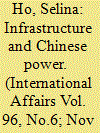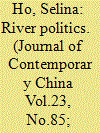|
|
|
Sort Order |
|
|
|
Items / Page
|
|
|
|
|
|
|
| Srl | Item |
| 1 |
ID:
178112


|
|
|
|
|
| Summary/Abstract |
China's increasing material capabilities stand at the heart of the US–China power transition debate. The focus on material power reflects a realist definition of power based on the possession of resources. However, material capabilities do not necessarily translate into influence and do not always determine outcomes. Non-material power matters at least as much as material capabilities. This article argues that China under President Xi Jinping views power differently from previous generations of Chinese leaders. While material power remains important, Xi has paid greater attention to strengthening Chinese non-material power, in particular structural power and discursive power. This article examines Chinese structural and discursive power, the third and fourth faces of power, through the lens of Xi's mega-infrastructure vision, the Belt and Road Initiative (BRI). It argues that power, both material and non-material, is embedded in infrastructure. Specifically, the article uses case-studies of Chinese construction of high-speed railways in Laos and Indonesia to illustrate the effects of Chinese structural and discursive power. Based on field work and in-depth interviews, the cases show that China is relatively successful in wielding structural and discursive power in Laos and Indonesia, despite the differences in the two countries’ political systems, and economic and population sizes. Chinese domination, however, does not mean that subordinate states do not have agency. For instance, there is resistance against the narrative of a pre-eminent Chinese civilization in Chinese discourse, as the Indonesia case demonstrates. Exploring the different facets of Chinese power is critical for a proper understanding of how China strives to shape the structure and discourse of the global order.
|
|
|
|
|
|
|
|
|
|
|
|
|
|
|
|
| 2 |
ID:
127770


|
|
|
|
|
| Publication |
2014.
|
| Summary/Abstract |
China manages its transboundary rivers as a subset of its broader relations with other riparian states. This results in discernible differences in the way China approaches its international river systems. Although there is a limit to the extent of Chinese cooperation, in relative terms China is more cooperative in the Mekong than in the Brahmaputra. To China, Southeast Asian states are part of a hierarchical system where it stands at the apex. While problems exist, there are deep linkages between them, which help foster collaboration in the Mekong. India, which has greater power parity with China, is not part of China's hierarchical worldview. The territorial disputes and security dilemmas that characterize South Asian geopolitics further impede cooperation. Domestic considerations also impact on China's river policies. There is greater consensus among Chinese policymakers in managing the Mekong than the Brahmaputra, which explains the higher degree of clarity in Chinese policies towards the former compared to the latter.
|
|
|
|
|
|
|
|
|
|
|
|
|
|
|
|
|
|
|
|
|